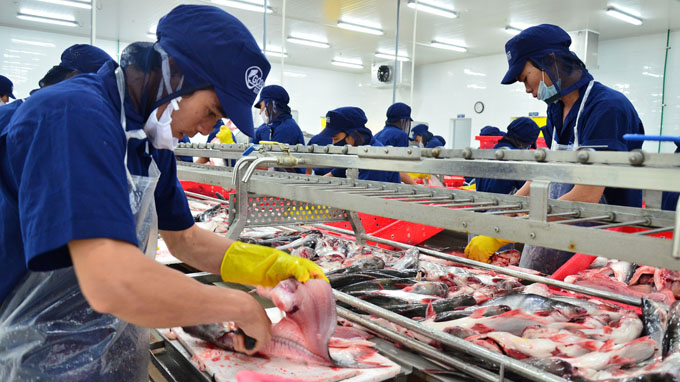|
Seafood sector aims high despite barriers
in international market
Seafood
producers and exporters have been warned that many barriers, from
protectionism to media campaigns, will affect them in the international
market in 2017.
 Vietnam estimates it exported $7.1 billion worth of seafood products in 2016, an increase of 8 percent compared with 2015, despite difficulties, including drought, saline intrusion and environmental disaster in four central provinces caused by Formosa’s untreated waste water discharge. VASEP (Vietnam Association of Seafood Exporters and Producers) have consulted with leading experts who say that there would be seven challenges for Vietnam’s seafood sector in 2017. The drought and saline intrusion which occurred in 2016 would continue tomhave effects on fresh water fish breeding. This would have a big impact on the cultivation area and material output. With trade barriers removed, Vietnam’s seafood products would have opportunities to penetrate the world’s markets.
However,
they would meet non-tariff barriers set up by import countries to prevent
them from penetrating the markets.
Import countries’ regulations on inspecting import quality are one barrier. Japan, for example, examines shrimp import consignments from Vietnam to detect Furazolidone, Enrofloxacin and Sulfadiazine. Meanwhile, Australia has announced it will strengthen the examination for biological toxins and microorganisms. From January to September 2016, 11 seafood consignments from Vietnam to the EU were warned for the heavy metal concentration (cadmium and mercury) higher than the permitted level. In the latest news, the Vietnam News Agency has reported an Australian ban on green and raw shrimp from Asia, including Vietnam, commencing from January 9. The Australian government banned Asian shrimp imports after detecting white spot viruses in shrimp sold at stores and after a white spot outbreak occurred in Queensland. The anti-dumping duty and catfish inspection program will still be a barrier to Vietnam’s catfish in the US market. With high anti-dumping duties, only two or three Vietnamese companies can keep exporting products to the market. Meanwhile, Vietnam’s material production cost is relatively high. A survey found that the production cost in Vietnam is 10-30 percent higher than in India and Thailand. This will make the material shortage become more serious. The risk is believed to come from media as well. On January 5, 2017, a video clip on Spanish television gave incorrect information about Vietnam catfish. However, despite the risks, Vietnam still hopes it can boost seafood exports in 2017. Nguyen Hoang Anh, general director of Nam Mien Trung Seafood Investment, first mentioned the possibility of earning $10 billion from shrimp exports. He said Vietnam, with its long coast and brackish areas in Mekong Delta, can expand the shrimp breeding area to 2 million hectares. In 2016, Vietnam exported $1.7 billion worth of catfish.
VNN
|
Thứ Năm, 26 tháng 1, 2017
Đăng ký:
Đăng Nhận xét (Atom)
Không có nhận xét nào:
Đăng nhận xét